Using and Creating Stencils
Stencils are reusable shapes that can be as simple as a square or triangle, or as complex as a multilayered and meticulously designed illustration of your cat. Once you create the thing and export a version as an OmniGraffle stencil file, you’ll never have to redraw that thing again. All you’ll need to do is locate the stencil in the Stencils Library and drag it to the Canvas.
This chapter shows you how to use the new Stencils popover menu and window to your advantage, how to create a new stencil and save that to your Mac, and how to properly set up your stencil in OmniGraffle.
Using the Stencils Popover Menu and Window
To open the Stencils popover menu, click ![]() in the toolbar, or choose Window ▸ Stencils.
in the toolbar, or choose Window ▸ Stencils.
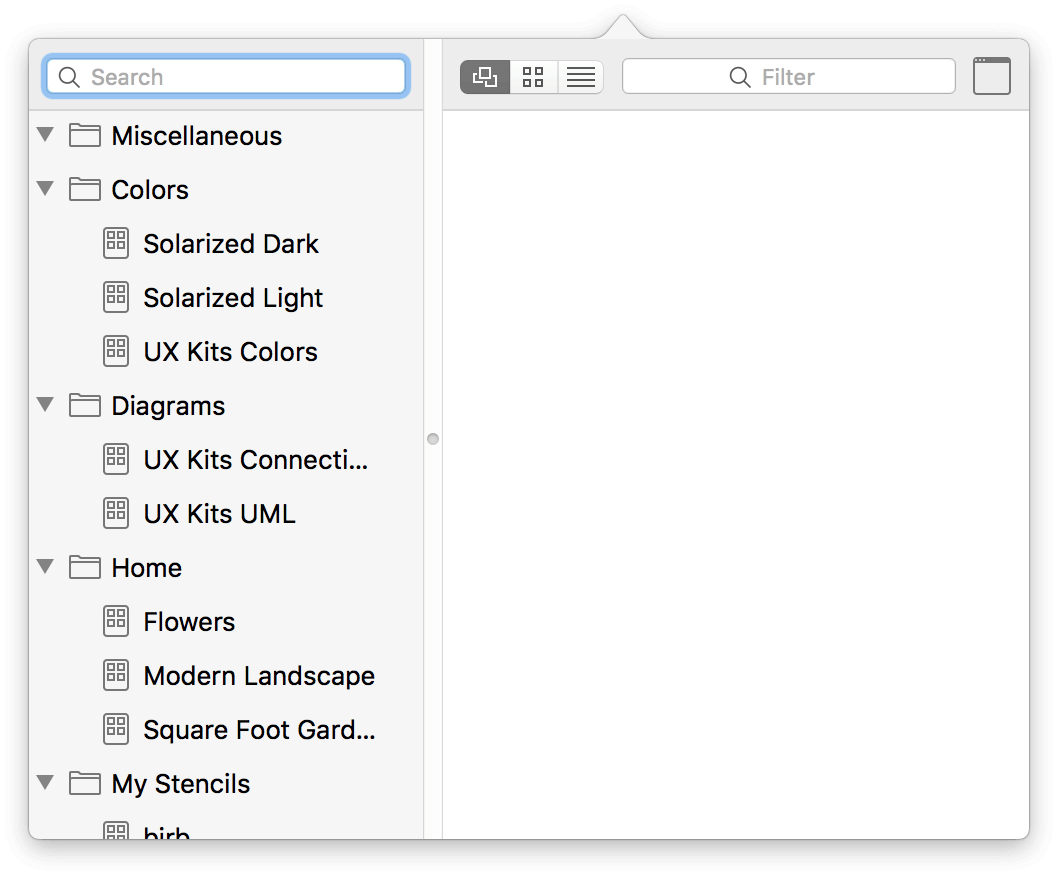
You can also choose to have the Stencils popover menu appear as a floating window, by either clicking ![]() in the upper-right corner of the Stencils popover, or by choosing OmniGraffle ▸ Preferences ▸ General ▸ Use floating stencil window.
in the upper-right corner of the Stencils popover, or by choosing OmniGraffle ▸ Preferences ▸ General ▸ Use floating stencil window.
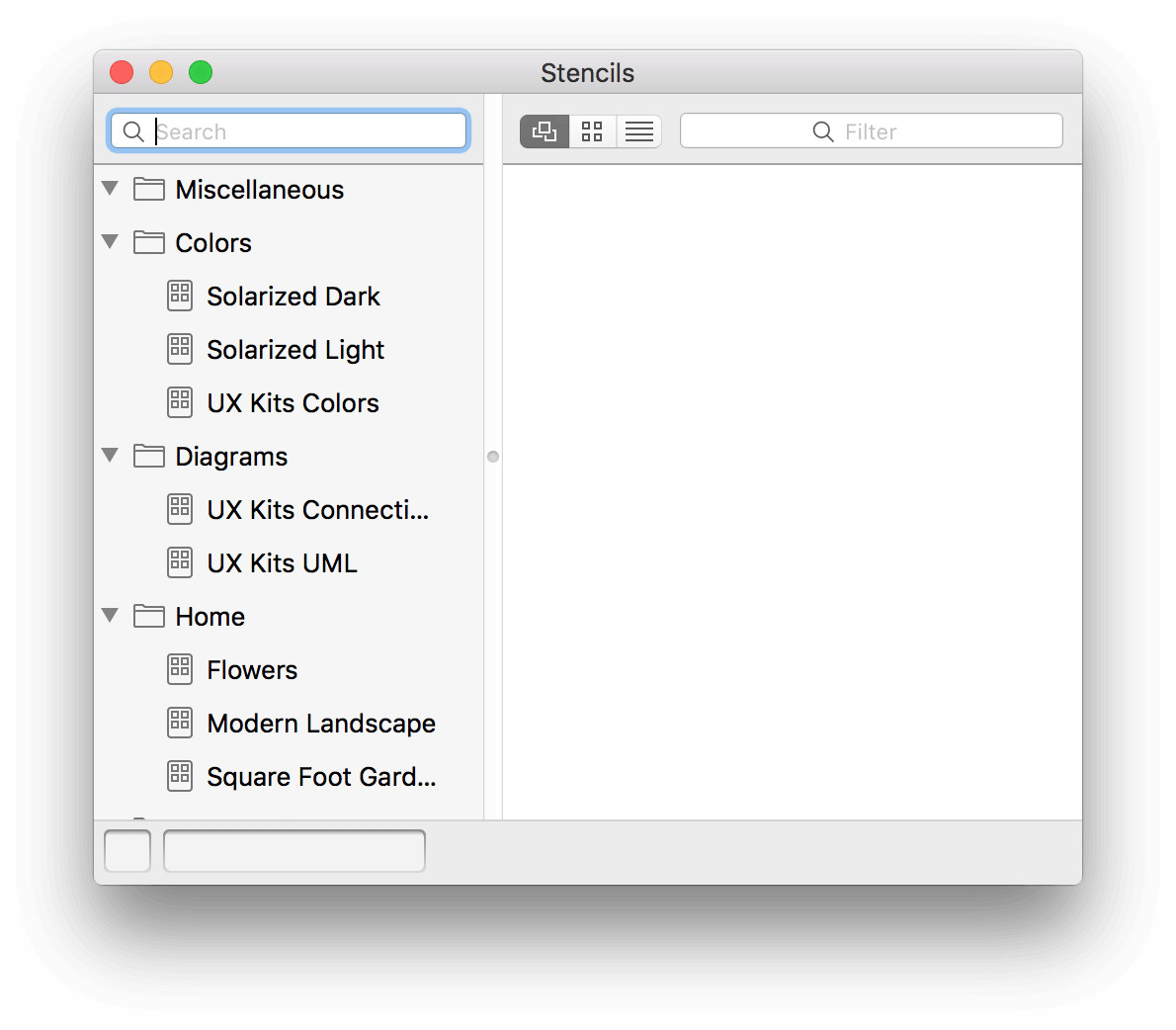
To add a stencil shape to your project, select the object you’d like to use, and then drag that object to the canvas.
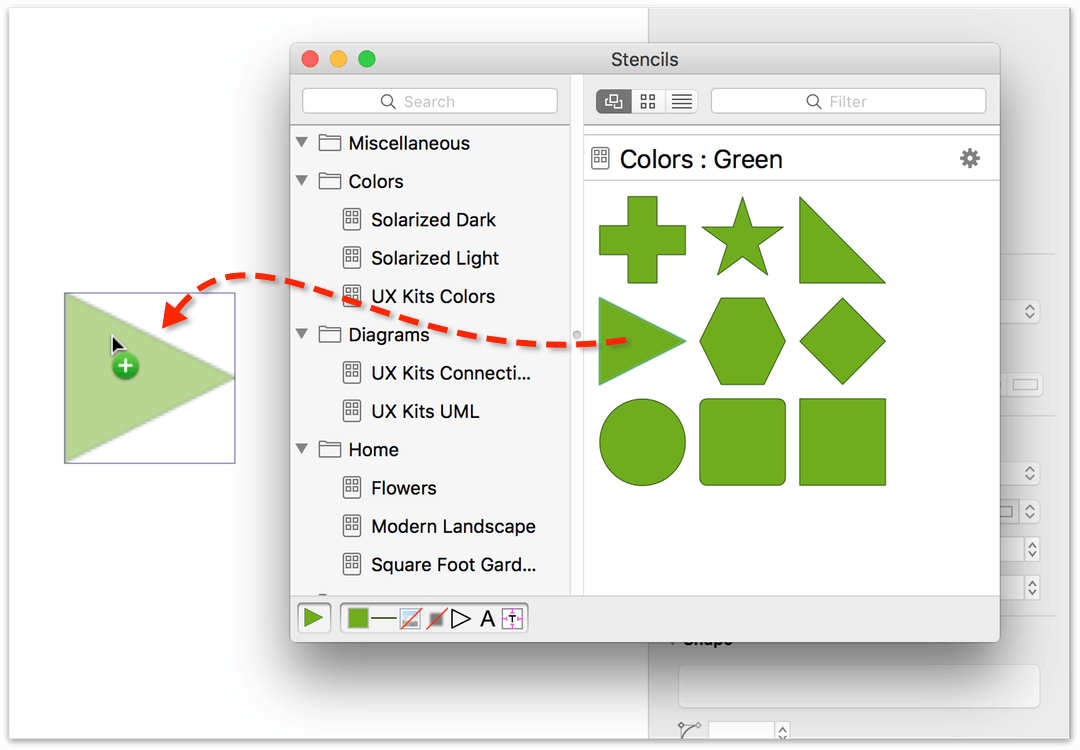
Once on the canvas, you can interact with the shape just as you would with any other object you draw. For example, you can rotate the object, edit the path with the Point Editor tool (requires OmniGraffle Pro), or use the shape to rapidly prototype a new web design.
Searching for Stencils
At the top of the Stencils window is a search field that you can use to search through the existing stencils in OmniGraffle and—as an added bonus—Omni’s own online user-supported stencil repository, Stenciltown.
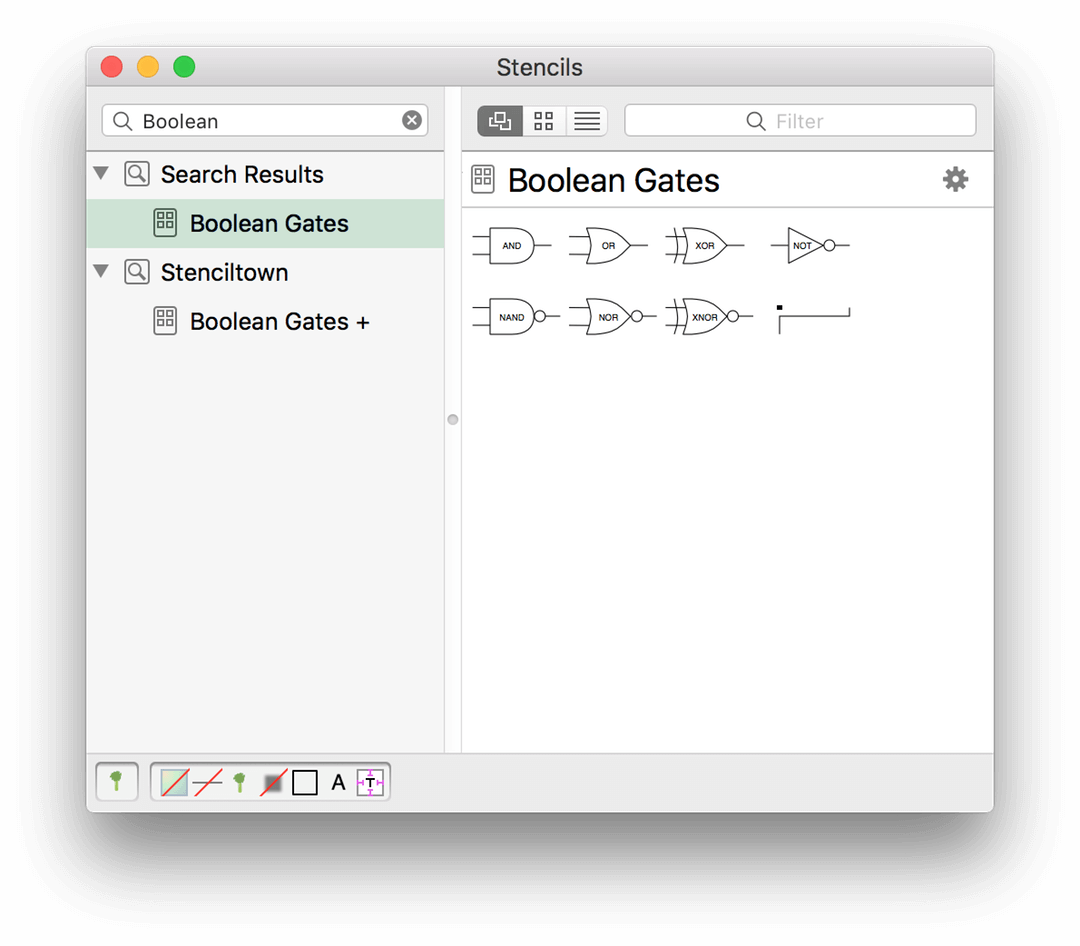
Stencils that already exist in OmniGraffle appear at the top of the search results, followed by anything new that’s been posted to Stenciltown.
How you use a stencil you’ve searched for depends on how it pops up in the results. Let’s say that you’re working on a techy diagram and you need some Boolean Gates. You click in the search field and start entering Boolean. As you type, OmniGraffle starts pruning what you see below. You’ll notice there are two categories of results:
-
Search Results displays stencils already available to you on your Mac. To use one of the stencils, click and drag it to the canvas.
-
Stenciltown displays applicably-named stencils which you can download from Stenciltown to your Mac. Start by clicking the Download button.
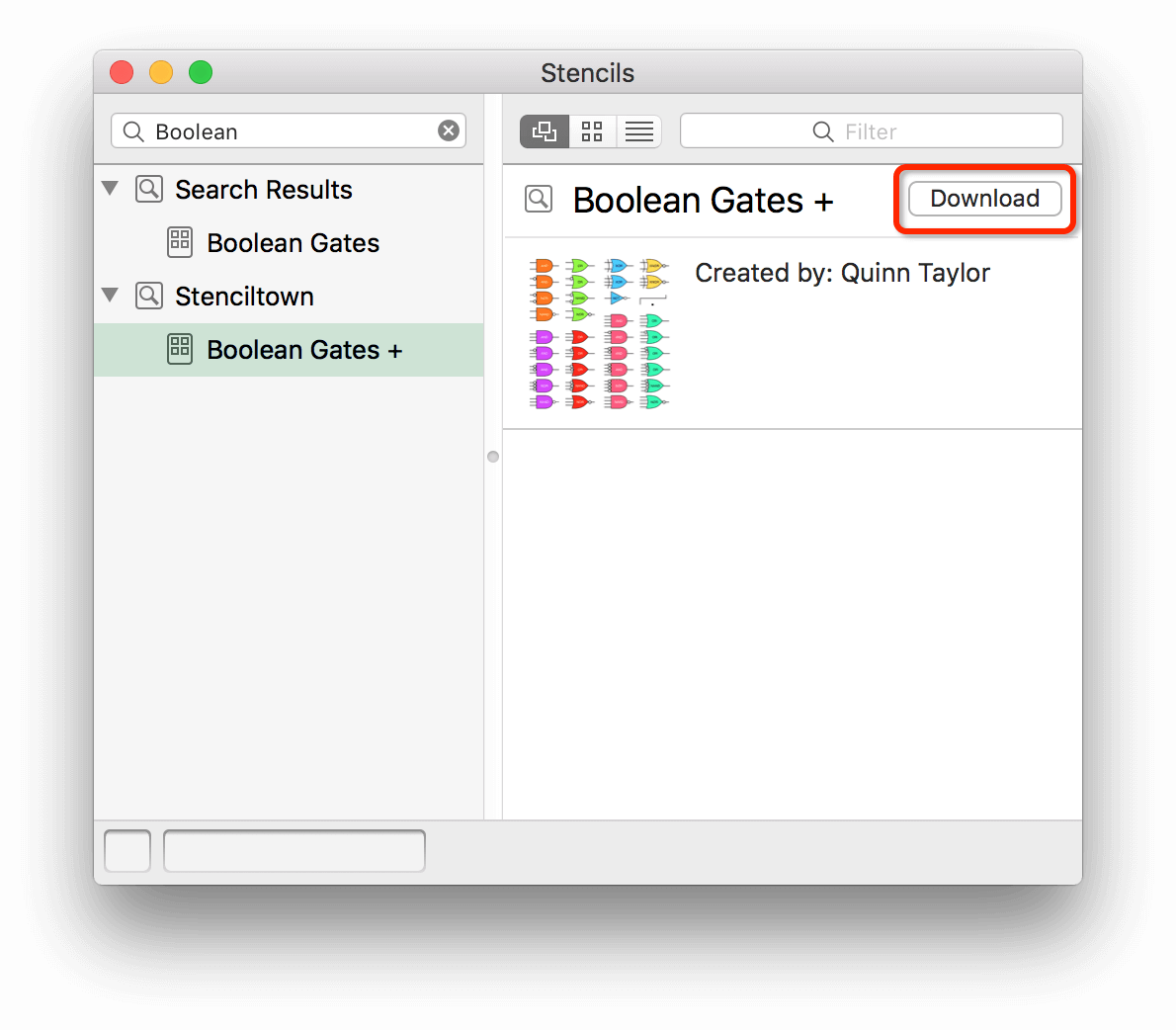
This downloads the stencil from Stenciltown and makes it available with all of the other OmniGraffle stencils on your Mac. Once downloaded, drag the stencil to the canvas.
OmniGraffle only searches for stencils on Stenciltown if your Mac is connected to the Internet.
If you can’t find the stencil you’re looking for, either in OmniGraffle or on Stenciltown, you could always draw your own stencil set in OmniGraffle. And, if you’re inclined, you could share that with other OmniGraffle users on Stenciltown.
Editing an Existing Stencil
If you ever need to edit a stencil—say, to change an object’s color or size—OmniGraffle makes it easy:
- In the toolbar, click
 to open the Stencils window.
to open the Stencils window. - Locate the stencil that you want to edit.
-
Click the Gear menu next to the stencil name, and then choose Edit Stencil if you want to edit and save the stencil file, or choose Edit a Copy from the menu:
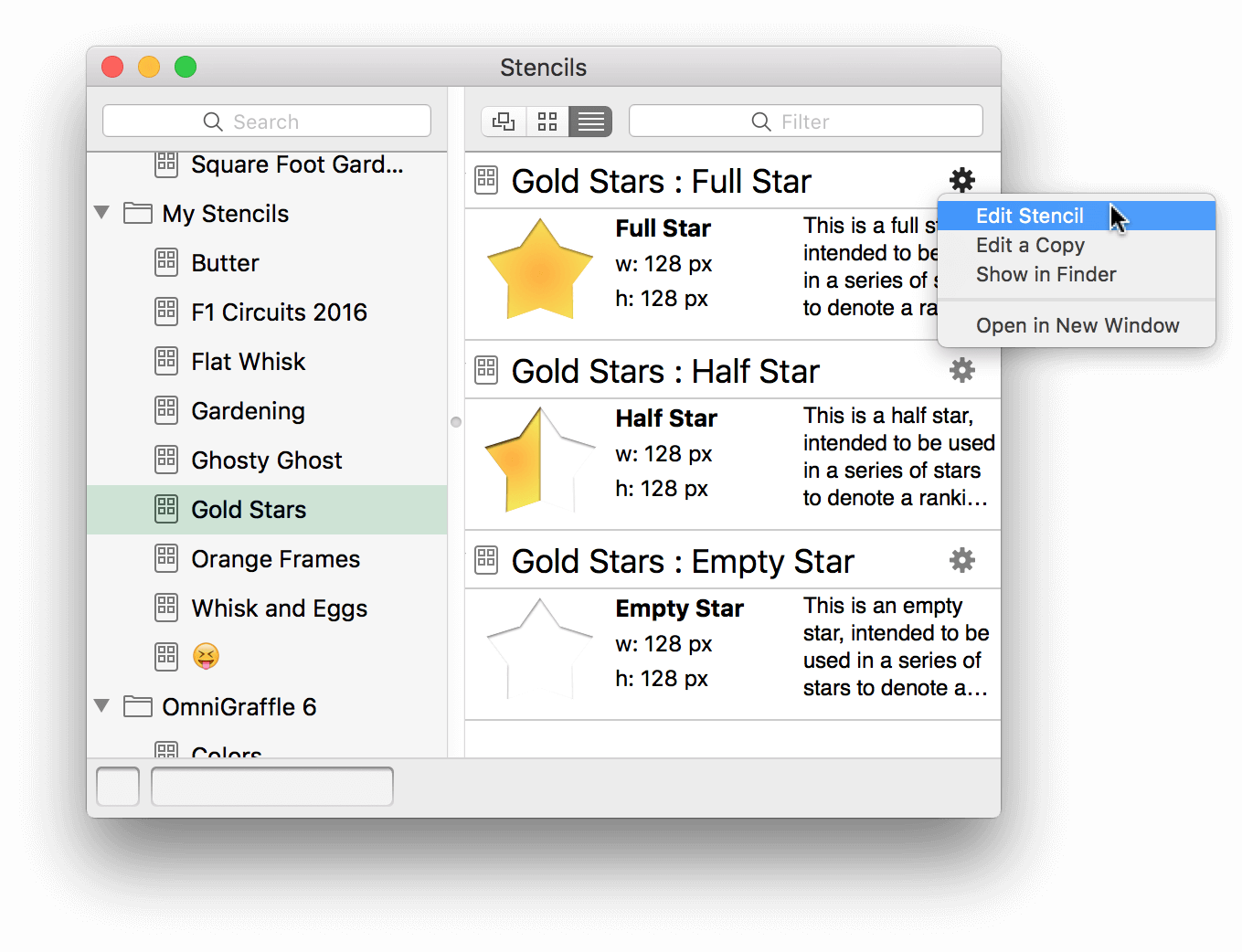
-
If you chose Edit Stencil, the stencil file opens for you to work on. When you have finished making your changes, saving the file overwrites the original file in the Stencils folder.
-
If you chose Edit a Copy, the contents of the stencil file are placed in a new, Untitled stencil file. When you’ve finished making your changes, be sure to give this stencil file a different name than its predecessor so you don’t overwrite the original.
-
Once the stencil is open in OmniGraffle, you can work on it just like you would with any other project.
Creating Stencils
Now that you know how to find and use a stencil, it’s time to learn how to create one. After all, part of the reason why you’re using OmniGraffle is to draw things, and there’s a good chance that you’ll want to reuse that thing again later. That’s where stencils come in!
What goes into making a great stencil, however, goes far beyond the artistic quality of the thing you create. There are some things you can do in OmniGraffle—from how you name the stencil file, naming canvases and objects, even adding descriptions for individual stencils—to help make your stencil usable and accessible to everyone who uses OmniGraffle.
The remainder of this chapter is devoted to showing you the ins and outs of creating a really great stencil file. So, let’s start at the beginning—creating the stencil file.
Creating a New Stencil from Scratch
To create a new stencil, choose File ▸ New Resource ▸ New Stencil. An OmniGraffle stencil file looks just like any other OmniGraffle file. You have the same canvas. The same inspectors. Even the same toolbar. Under the hood, though, OmniGraffle specifies and recognizes this file as a reusable stencil.
However, when you save the stencil file, OmniGraffle’s save sheet opens to the Stencils folder on your Mac:
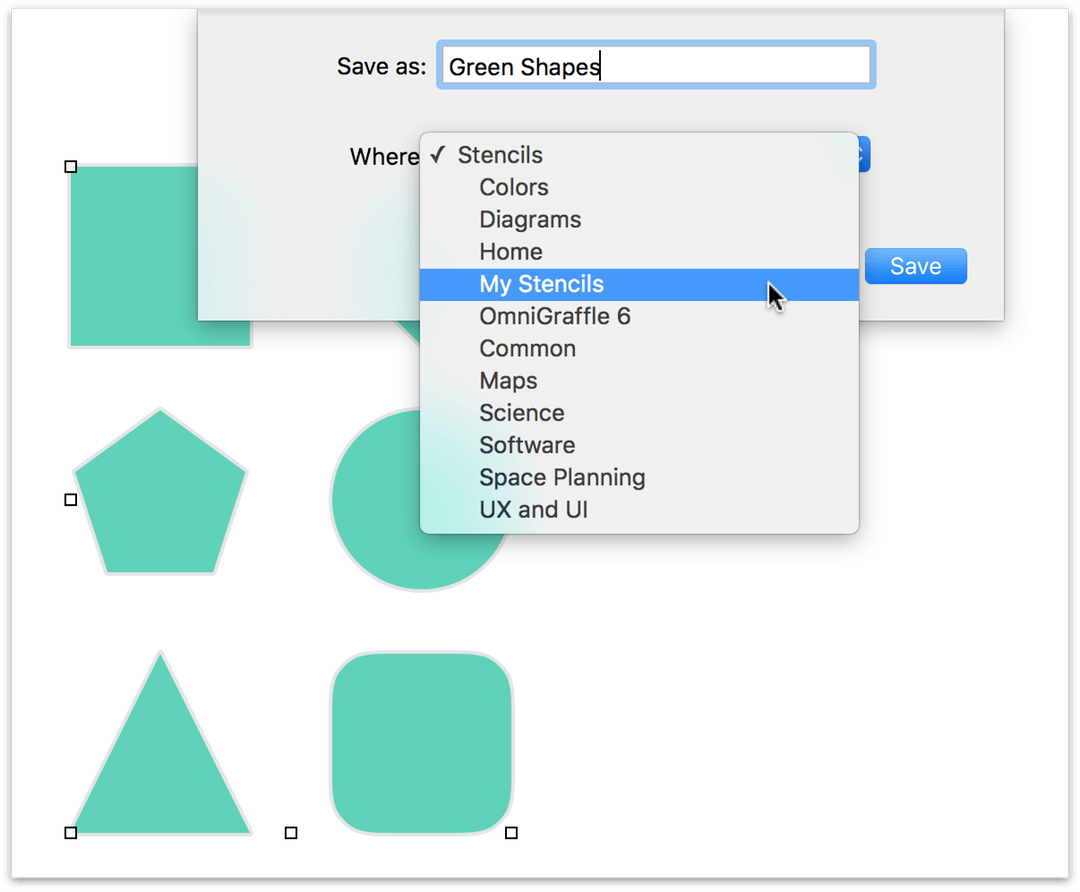
Using the Where menu, you can choose to save your stencil in the Stencils folder, or to any subfolder within that directory. After you click Save, your stencil is immediately available for use from the Stencils window.
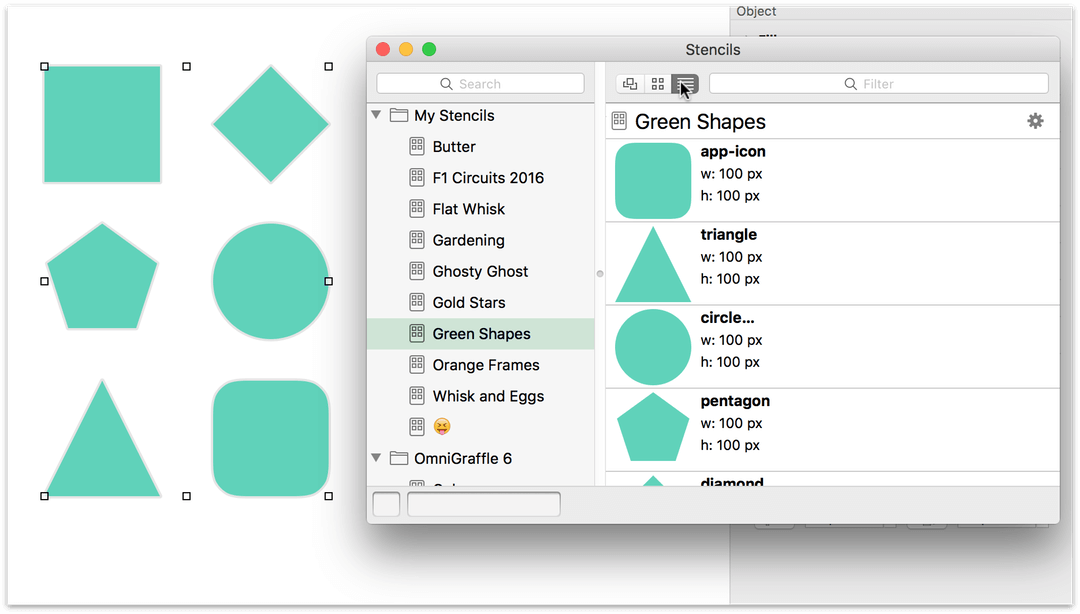
Creating a Shortcut to the Stencils Folder
To make the process of Exporting an OmniGraffle Document as a Stencil to the Stencils folder a little easier, you’ll need to create a shortcut to the stencils folder in the Finder’s sidebar.
The Stencils folder lives deep within OmniGraffle’s container, but there’s a quick way to get to the Stencils folder from within OmniGraffle. Follow along...
-
In the toolbar, click
 to open the Stencils window. If the Stencils window appears as a popover menu, click
to open the Stencils window. If the Stencils window appears as a popover menu, click  .
. -
In the Stencils window, select any stencil in the listing along the left, and then click its Gear menu and choose Show in Finder:
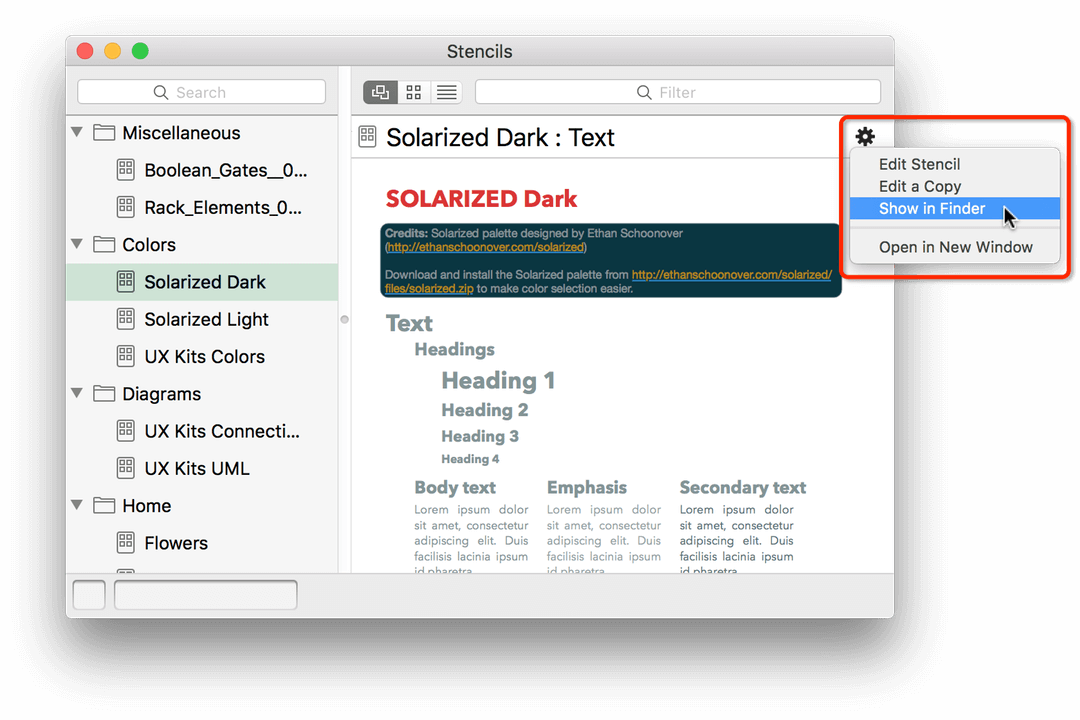
This opens a Finder window with that particular stencil selected:
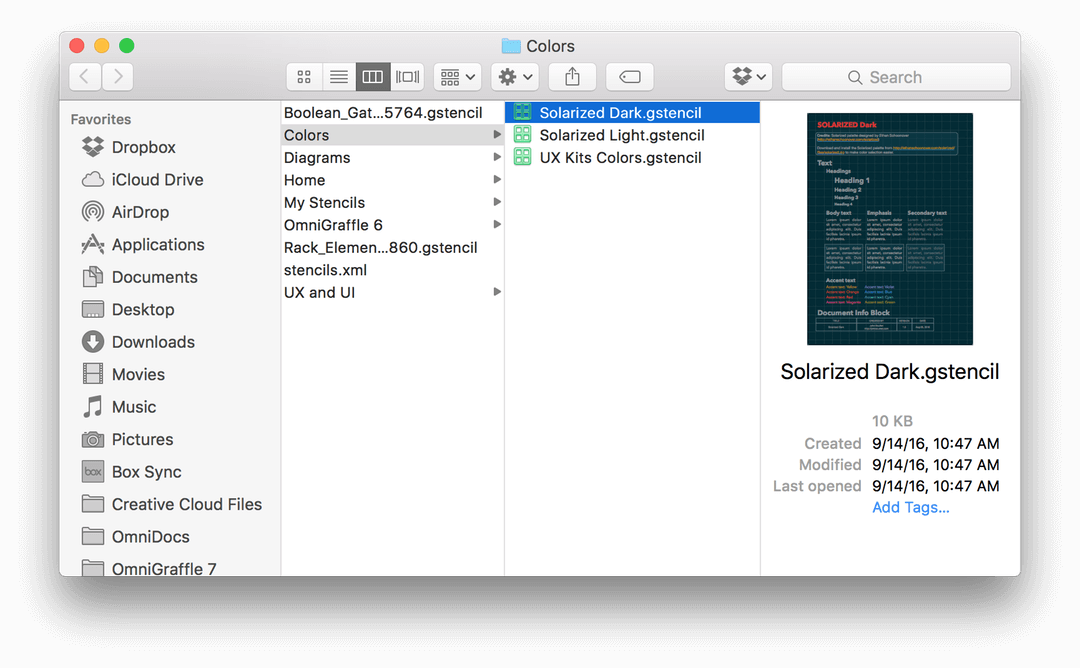
-
With the Finder window selected, choose View ▸ as Columns (Command-3).
-
Scroll the Finder view backward until you see the Stencils folder; click to select the Stencils folder:
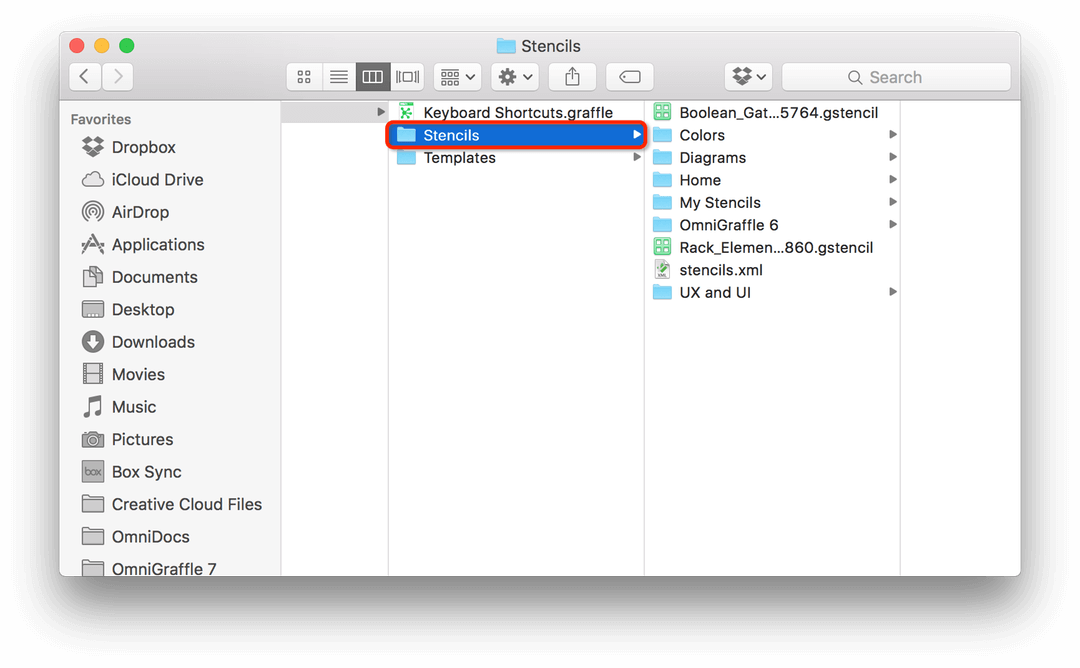
-
With the Stencils folder selected, choose File ▸ Add to Sidebar (Control-Command-T). This adds a shortcut to the Stencils folder in the Favorites section of the Finder’s sidebar.
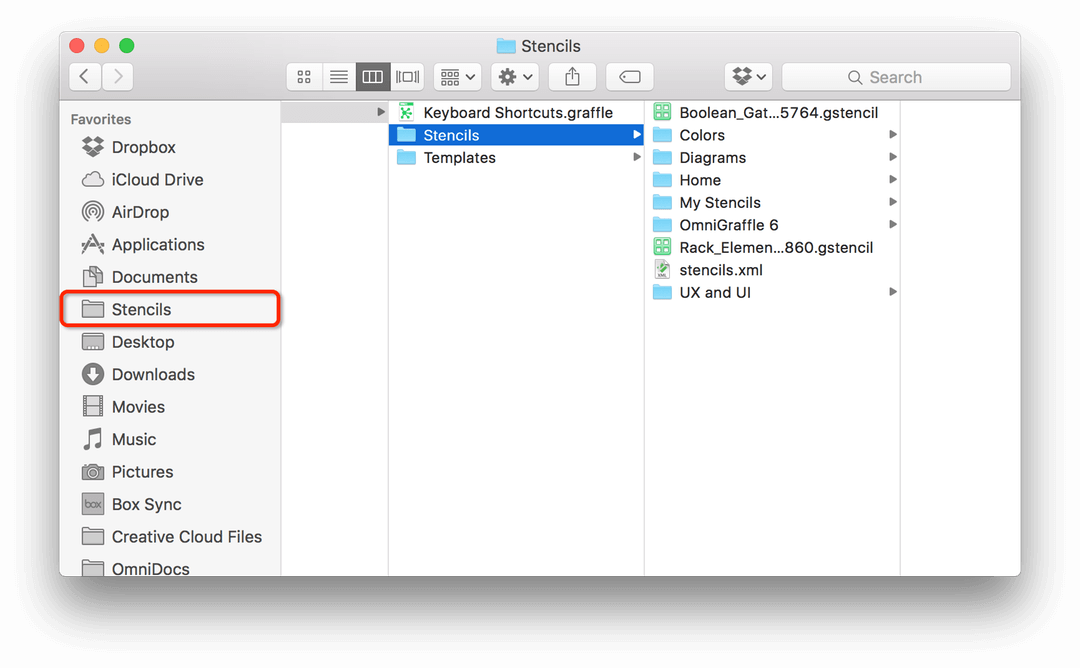
Now when you need to add a stencil to the Stencils folder, you can use the Finder or choose the Stencils folder in the Favorites list on the left side of the save sheet.
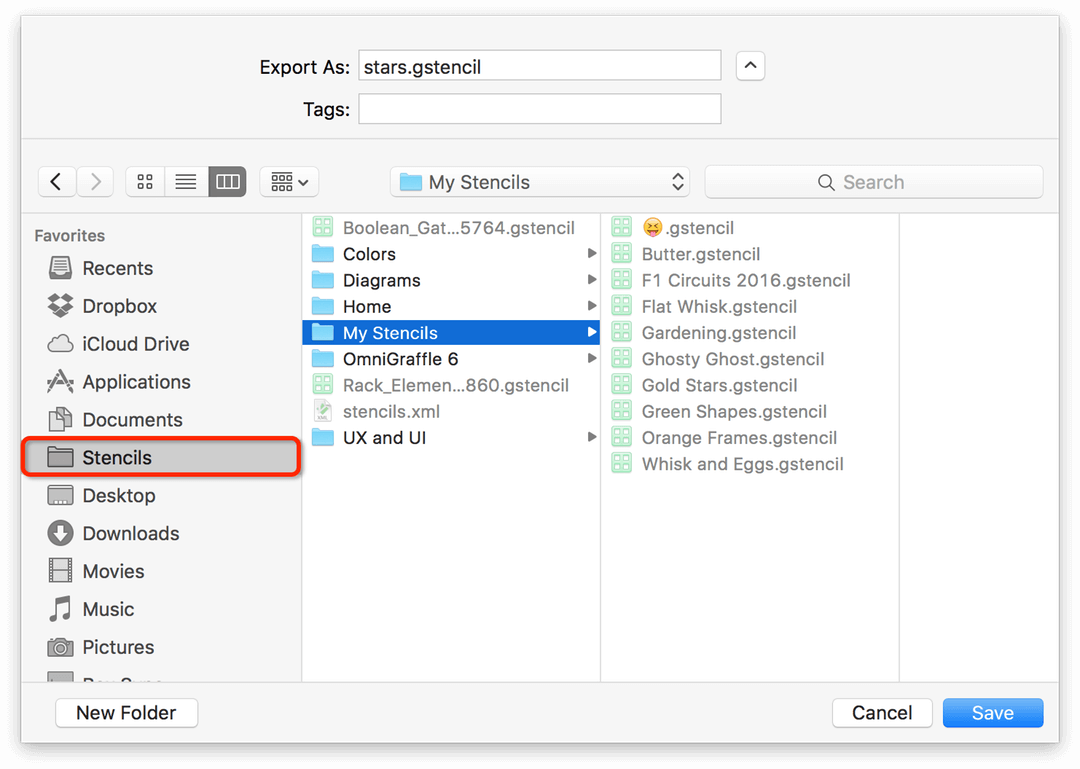
The other benefit of adding the Stencils folder as a favorite to the Finder’s sidebar, is that you quickly add subfolders to organize your stencils, as well as rename or delete stencils, too.
If you need to access the Stencils folder from a script you are writing, the Unix path to use is:
-
Non-Mac App Store purchases:
~/Library/Containers/com.omnigroup.
OmniGraffle7/Data/Library/
Application\ Support/The\ Omni\Group/
OmniGraffle/Stencils -
Mac App Store purchases:
~/Library/Containers/com.omnigroup.
OmniGraffle7.MacAppStore/Data/Library/
Application\ Support/The\ Omni\Group/
OmniGraffle/Stencils
Exporting an OmniGraffle Document as a Stencil
If you have an existing design in OmniGraffle that you would like to also use as a stencil, do the following:
-
Open your OmniGraffle file. If the file contains multiple objects, each object on the canvas is recognized as an individual stencil:
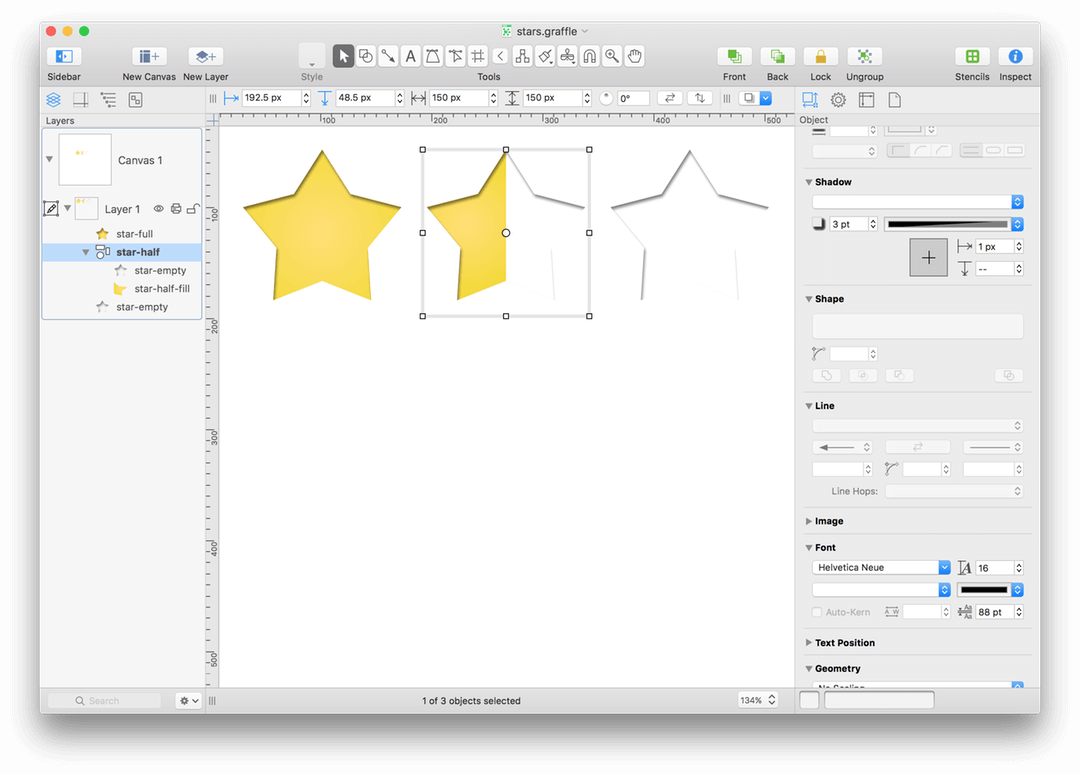
-
Choose File ▸ Export (Option-Command-E).
-
In the Export sheet:
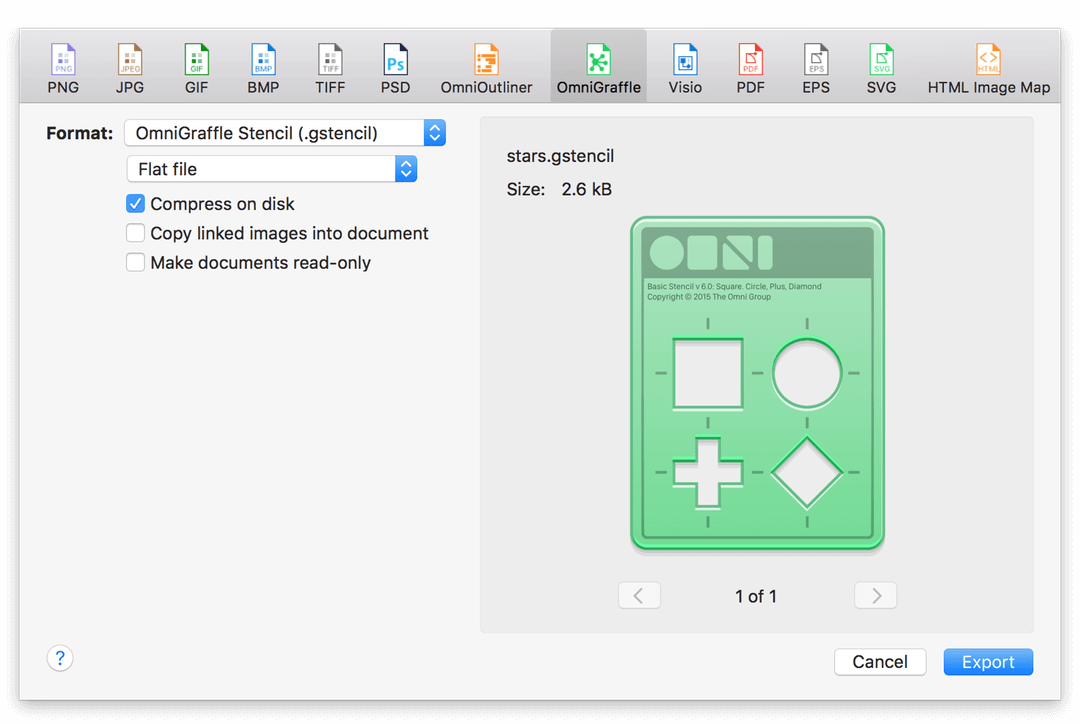
- Choose OmniGraffle in the row at the top of the Export panel.
- In the Format popup menu, choose OmniGraffle Stencil (.gstencil).
- In the next pop-up menu, choose whether to save the stencil file as a Package File, a Flat File, or Automatic.
- Select any of the following options, depending on your needs:
- Compress on disk
- Copy linked images into document
- Make documents read-only
-
Click Export; this opens a Save sheet on top of the Export panel:
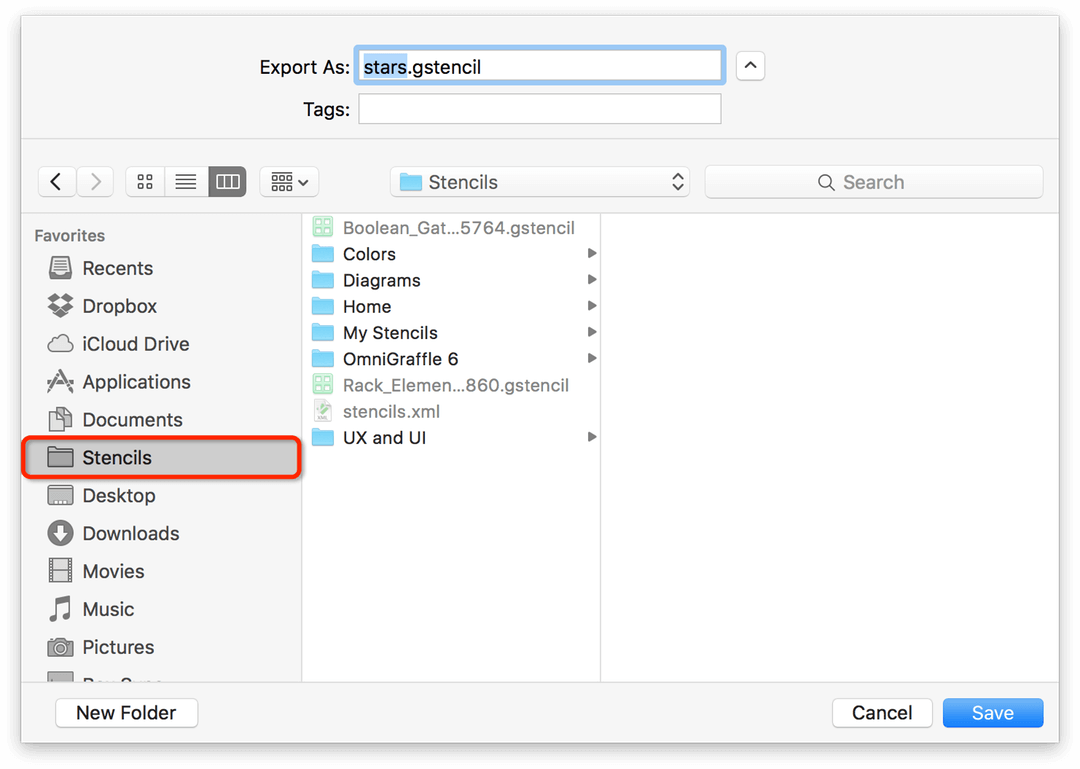
If you added the Stencils folder to the sidebar (see Creating a Shortcut to the Stencils Folder), choose the Stencils folder and then choose a folder in which to save the stencil file.
-
Click Save.
The stencils are ready and waiting for you in the Stencils window after exporting.
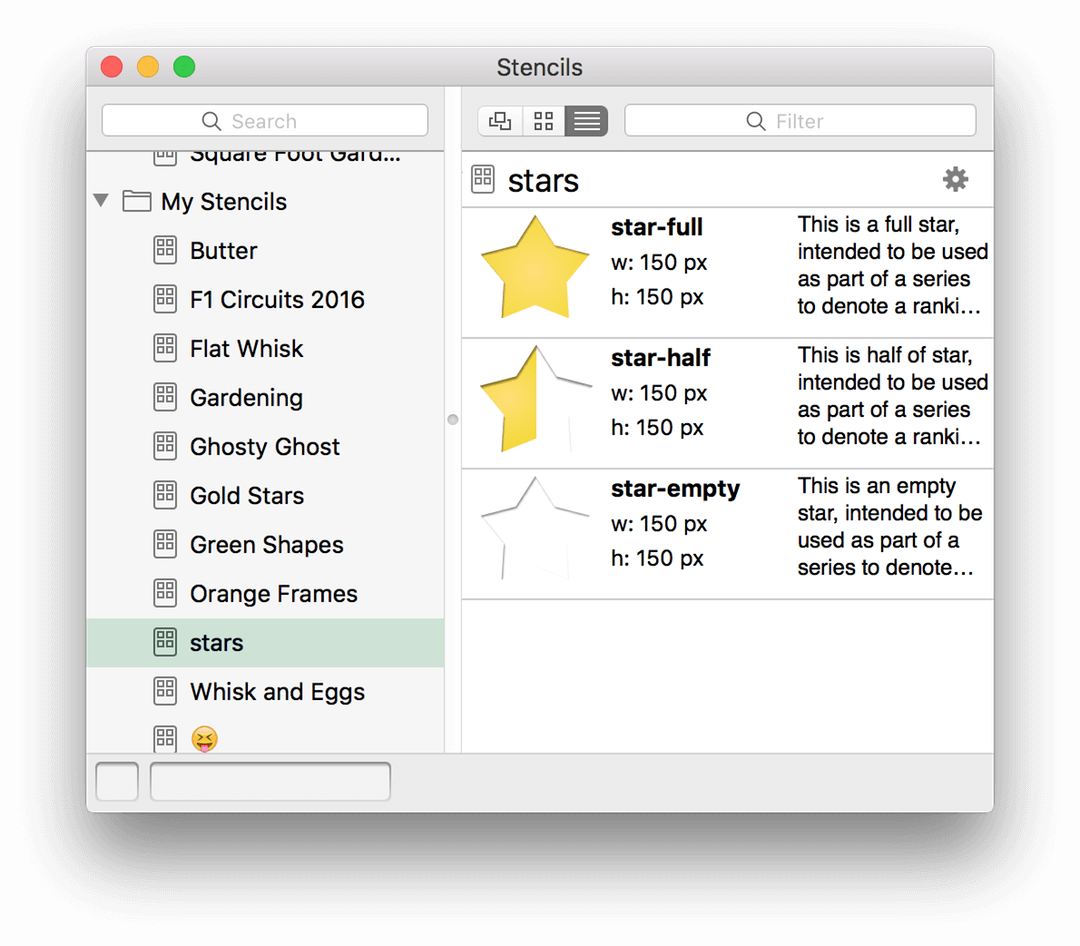
For more information on how to export files from OmniGraffle, see Exporting Image and Graphics Files from OmniGraffle, later in this guide.
Tips for Creating a Great Stencil
Beyond the design aspect of creating a great stencil, there is plenty more that you can do to your stencils to make them more useful for other users, particularly if you intend to share them on Stenciltown. For example, how you name the actual stencil file can make a huge difference in how users see your stencil in the Stencil Library.
Here you’ll find a series of tips for things you can do with your stencils in OmniGraffle to help make them stand out in the Stencil Library. To get started, though, let’s look at The Anatomy of a Stencil...
The Anatomy of a Stencil
A Stencil is a single object (or a single thing consisting of a group of objects), whereas a Stencil Set consists of two or more stencils of similar meaning. For example, a Stencil Set could contain all of the icons for your website, or the ingredients you need for various baking projects you’re trying to illustrate.
When you look at a stencil in OmniGraffle for Mac’s Stencil Library, you can see all kinds of information about that stencil, such as its name, size, whether it’s part of a Stencil Set—even whether a particular stencil is on its own canvas in the original stencil file. If you’re creating stencils, here’s where all of that information comes from:
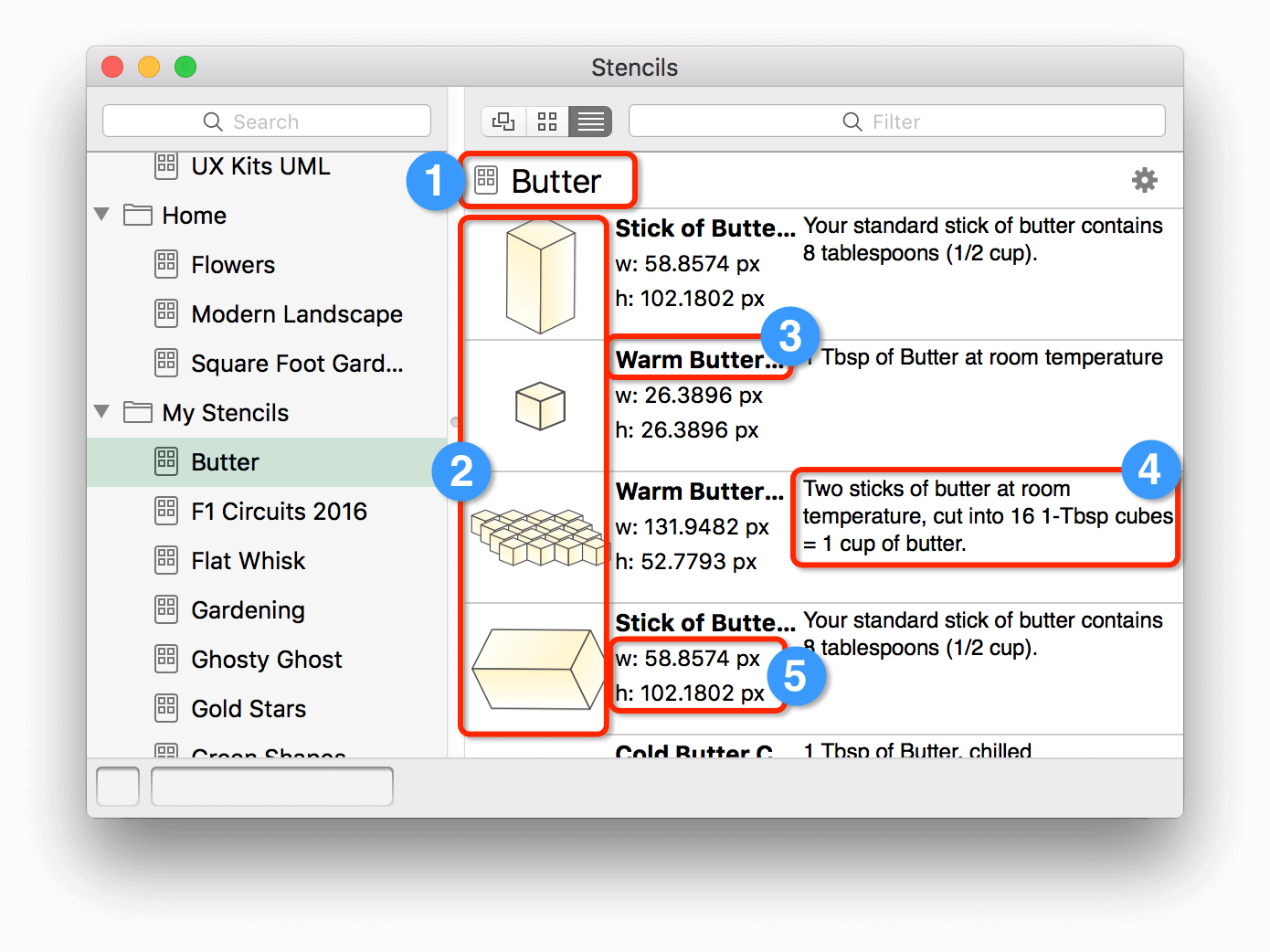
-
Stencil Filename: The name of your stencil comes directly from the filename you’ve chosen when you save or export the stencil file. Don’t use underscores or hyphens in the filename, and if you intend to share your stencil on Stenciltown, please don’t be cryptic when naming your stencil file. While a cryptic filename might work for your own use, that sort of thing doesn’t translate very well for the potential thousands of OmniGraffle users who are trying to find your stencil.
-
Stencil Ordering: If you create a Stencil Set, the order in which your stencils appear on the canvas matters. Use the Contents pane in the Sidebar to see how the objects are ordered on the canvas.
-
Stencil Name: If you have a Stencil Set, you can assign names to the individual stencils in that collection by placing them on separate canvases and then naming each canvas accordingly.
If you have OmniGraffle Pro, you can name stencils in the Note inspector’s Name field. For more information about the Note inspector, see Adding Data to Objects with the Note Inspector (PRO), earlier in this guide.
-
Description: Also in the Note inspector (requires OmniGraffle Pro), use the big open text field to enter a short description for the thing you’ve created.
-
Dimensions: A stencil’s dimensions are based on your settings in the Units inspector. You can get to the Units inspector by choosing Inspectors ▸ Canvas, and then scroll through the inspectors to open up the Units inspector.
One or Many Objects Per Canvas?
There is no restriction on the number of objects you can have on the canvas. Every object, or group of objects, is its own stencil. For example, if you have three objects on the canvas—two standalone objects and a group of multiple objects—then your stencil file contains three different stencils.
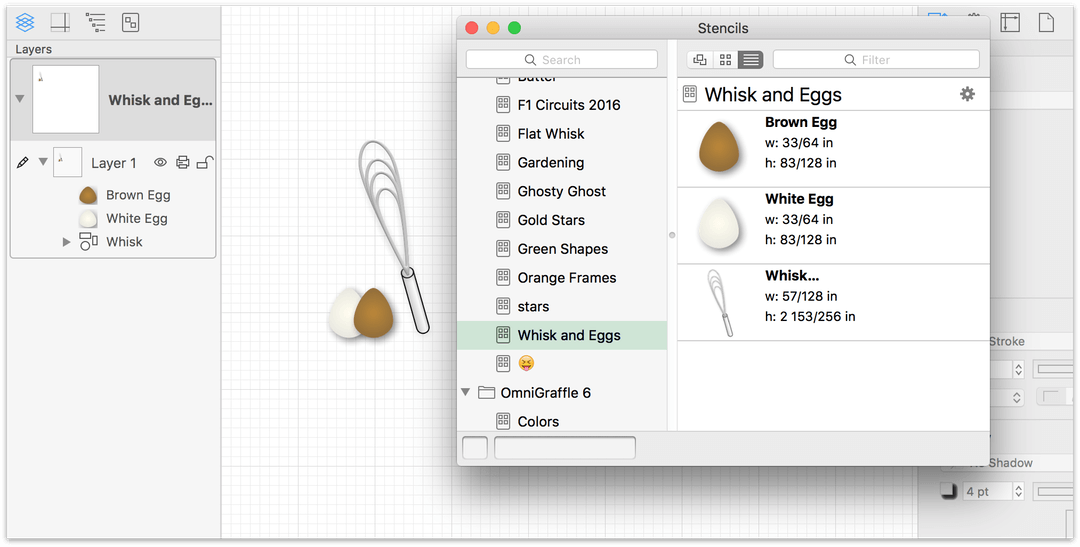
Group Objects That Make Up The Thing
Let’s say that you’re creating a bunch of stencils for standard kitchen utensils, such as whisks, spatulas, slotted spoons, and so on. Each thing you draw probably consists of multiple objects. If you don’t group together all of the objects for a particular item (for example, that whisk), each of those objects are exported as separate stencils.
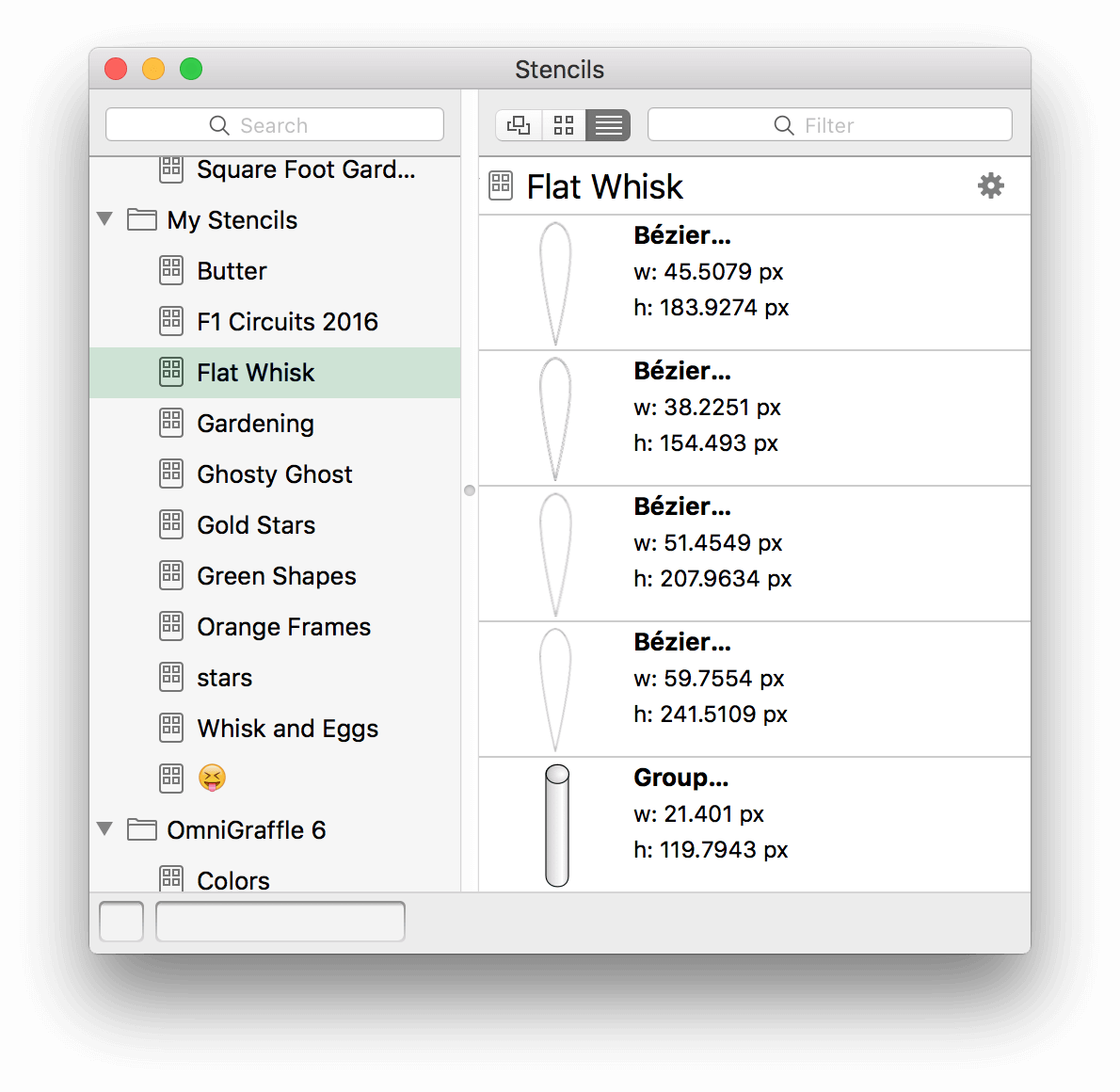
As you can see, rather than being a single stencil of a whisk, the stencil contains five objects: one for the handle, and four wire loops that make up the flat head of the whisk. However, if you group the objects together, you’ll get a single stencil object of the whisk:
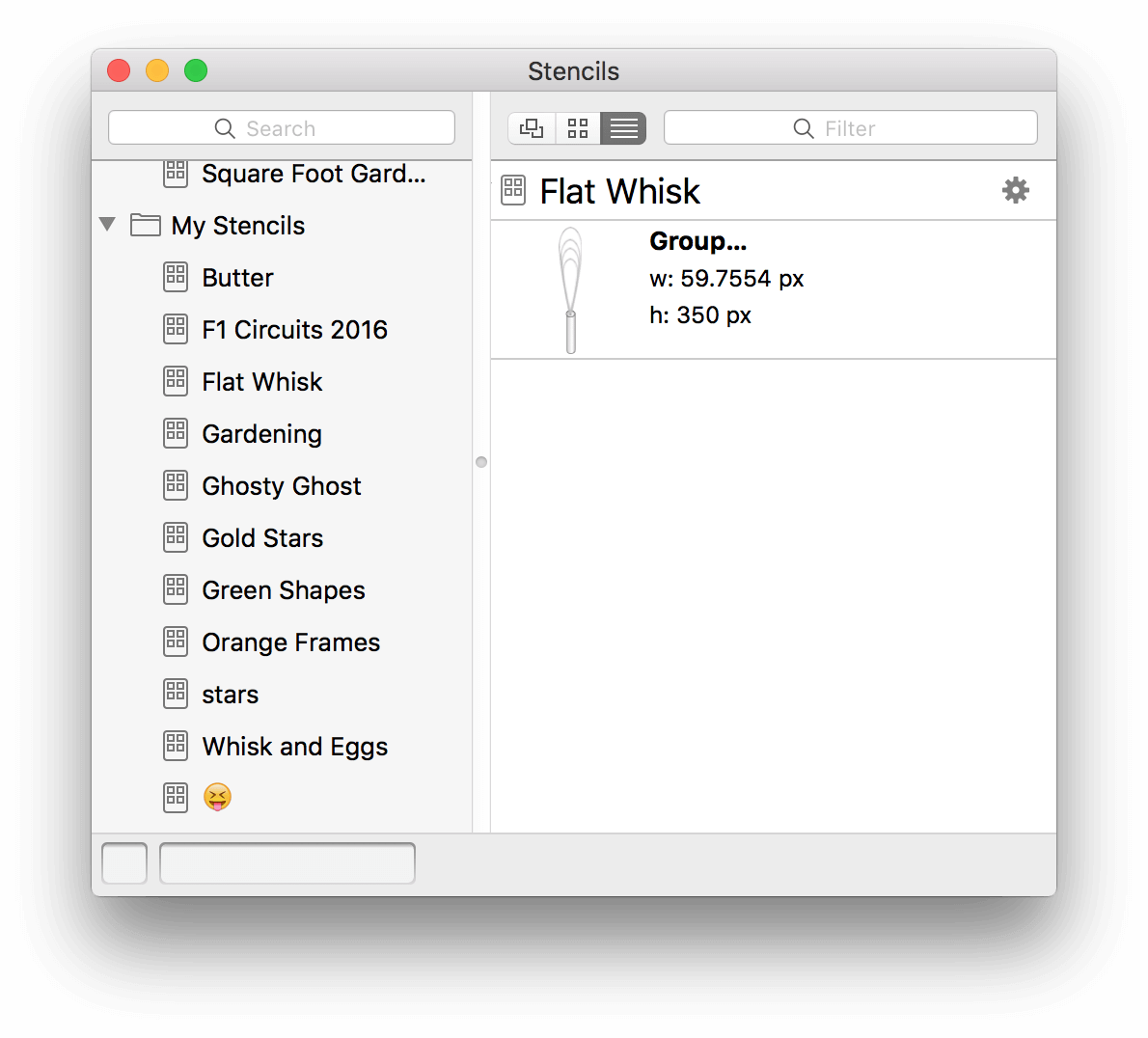
Naming Canvases
Even if your OmniGraffle document only has one canvas, don’t just leave it named “Canvas 1”. Instead, enter a short name to the stencil, such as “Espresso Machine” or “Website Prototype”. This is particularly essential when you have a stencil file with items spread across multiple canvases.
The way to identify a stencil that’s on a separate canvas is to look at the Stencil Filename. If the filename is followed by a colon (:) and another name, that second name is the Canvas Name. In the following example, the Stencil Name was added using OmniGraffle Pro’s Note inspector.
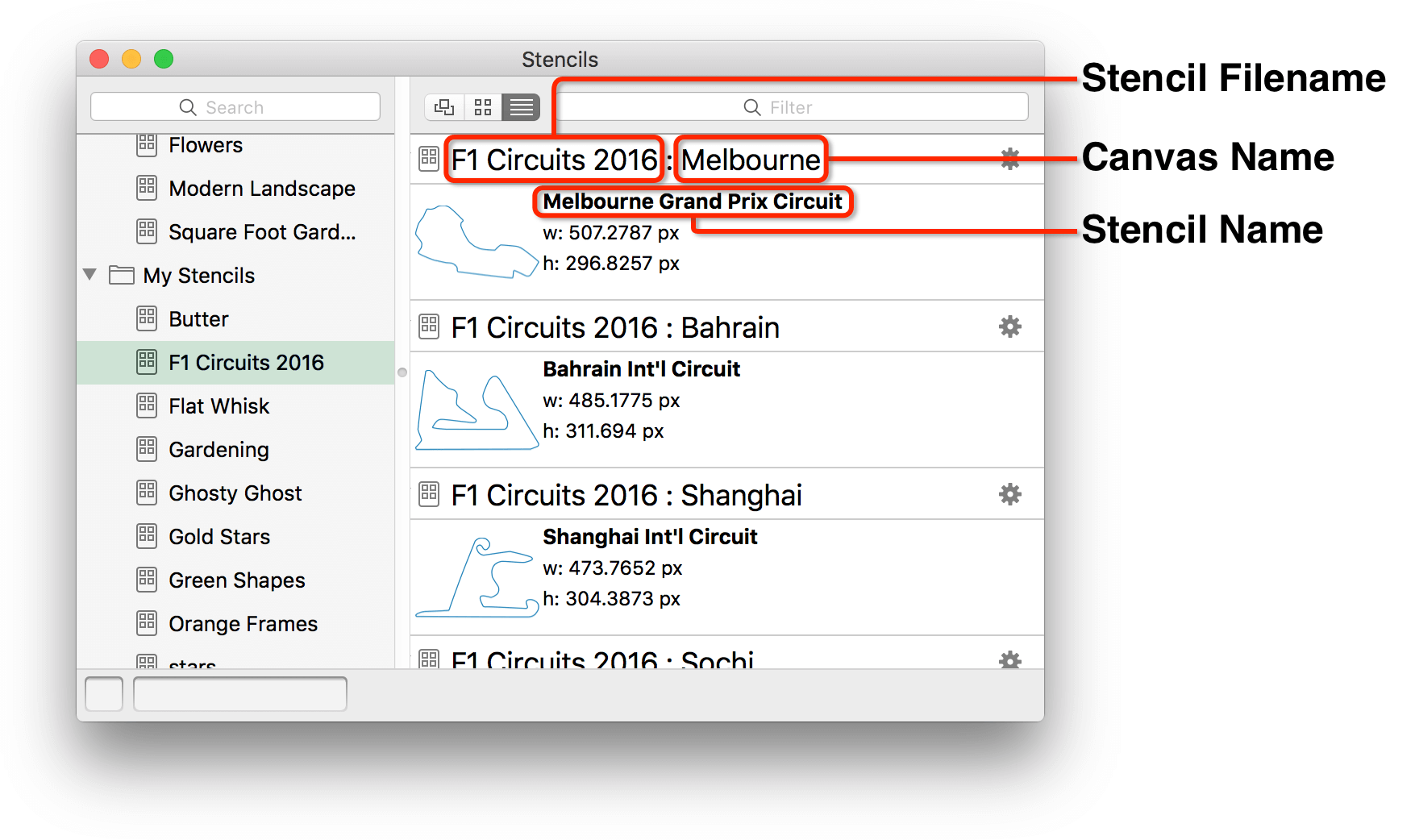
Neatly Organizing Stencil Sets
Another way you can better present the stencils in a Stencil Set is to organize them in the Sidebar. To reorder the objects in the Sidebar, click and drag them up or down in the list:
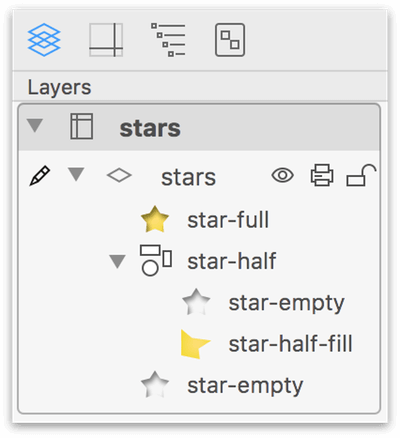
This sets the order in which your stencils appear in the Stencils Library; for example:
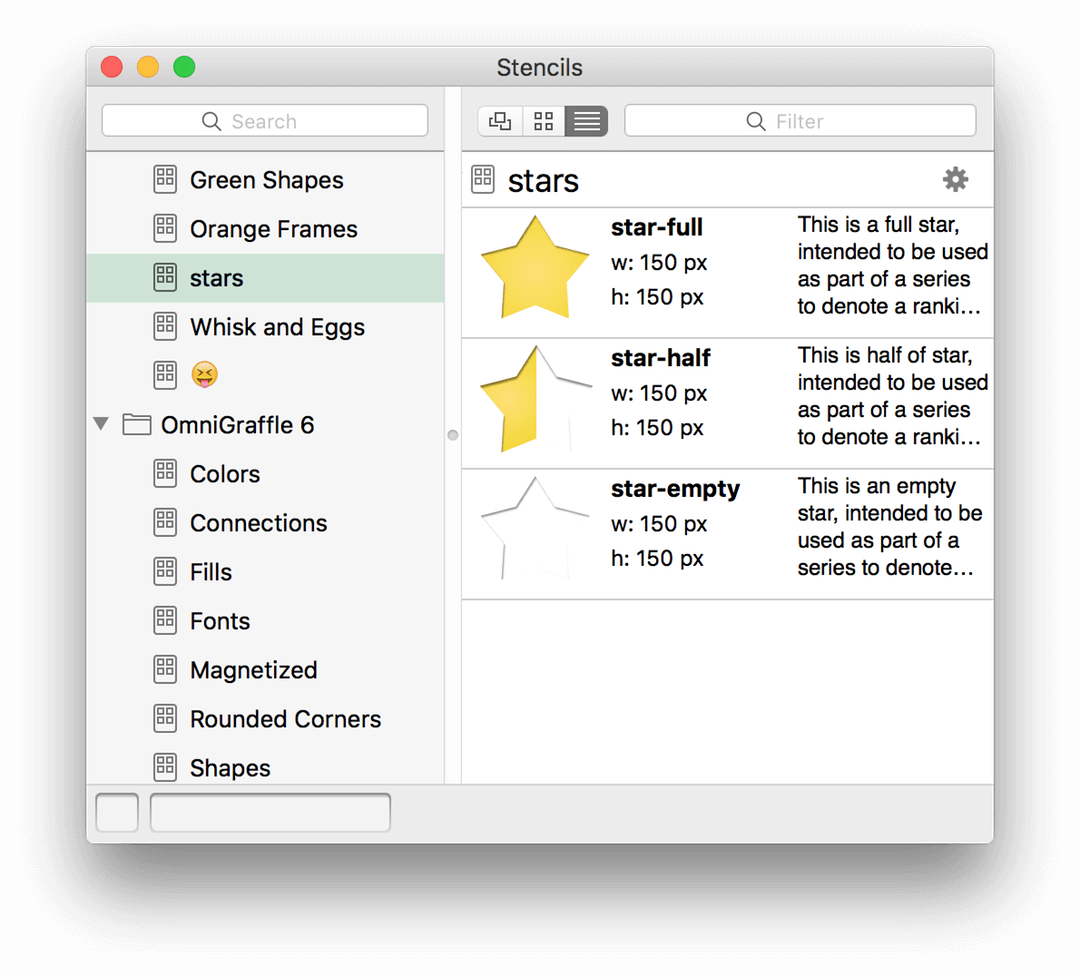
There is no right or wrong way to organize your stencils; just use your best judgment.
To Scale or Not to Scale?
One of the great things about stencils, is that you can take whatever the shape or thing might be, and resize it to the size you need. To aid in this behavior, use the Geometry inspector and turn on the Maintain Aspect Ratio option.
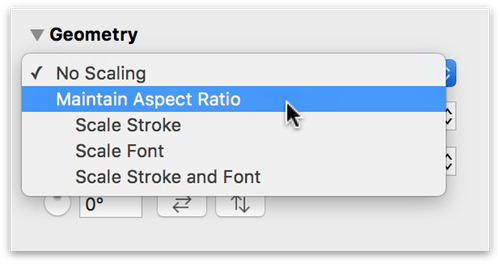
Once Maintain Aspect Ratio has been enabled, you can also choose to scale the stencil’s contents, including the stroke and text. And, if the person using your stencil decides they want to resize it without scaling, they can always turn off Maintain Aspect Ratio.
Sharing Stencils on Stenciltown
Stenciltown is an online community for sharing OmniGraffle stencils. When you use the Stencils window to search for new stencils, OmniGraffle also reaches out to Stenciltown and displays any results that match your search criteria. And, if you are working on a stencils file, you can also choose File ▸ Submit to Stenciltown to upload your stencils to Stenciltown, directly from within OmniGraffle.
To get started, you’ll need to create an account on Stenciltown. Your Omni ID consists of a username, your email address, and a password. That’s all of the information we require; just make sure that your password is a mixture of upper- and lowercase letters, numbers, and then toss in the occasional symbol. We don’t need your mailing address, names of your children or pets, or anything like that. Your Omni ID is, at the moment, your way of signing into and sharing stencils on Stenciltown.
How to Properly Name a Stencil File to be Shared on Stenciltown
Don’t be cryptic when naming your stencil file. Use something that aids in findability. For example, you could use something like F1 Circuits 2016 for a stencil set that contains outlines of the circuits for the upcoming Formula One season.
Don’t use underscores or hyphens in filenames. If you have a stencil, such as F1 Circuits 2016 that normally has spaces in it, don’t resort to using hyphens or underscores in the filename if that’s normally how you roll. Leave the spaces in there; they make the stencil name easier to read.
Finally, don’t use an emoji as the filename of your stencil. Since the point of sharing stencils on Stenciltown is to help other OmniGraffle users find the things they need, using an emoji as the filename hinders that process.
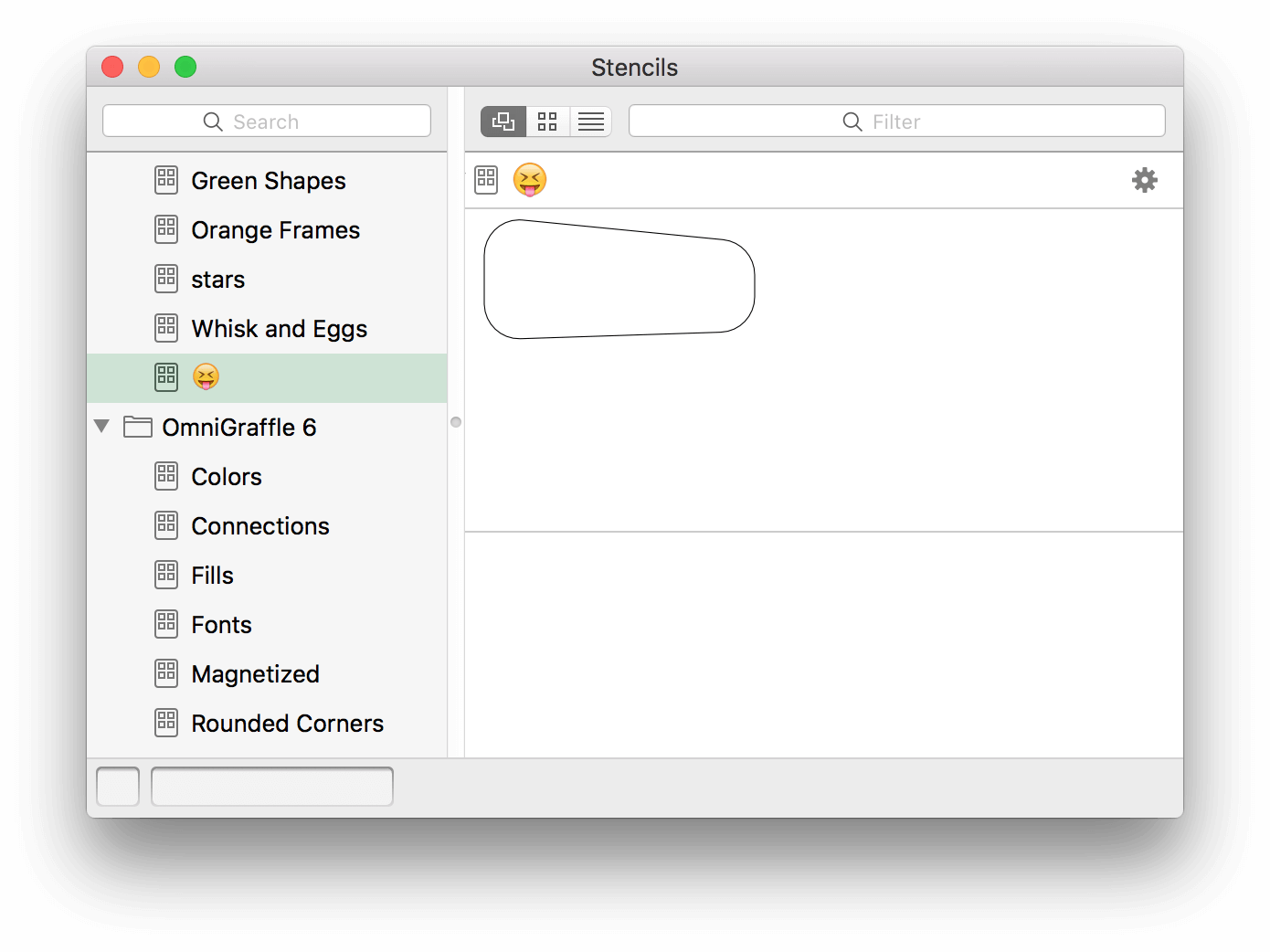
Submitting Stencils to Stenciltown
Once you have created your Omni ID for Stenciltown, you can log into Stenciltown directly from OmniGraffle on your Mac. Just follow these steps:
- With a stencils file open in OmniGraffle, choose File ▸ Submit to Stenciltown.
-
In the sheet that appears, enter your Username and Password, and then click Log In:
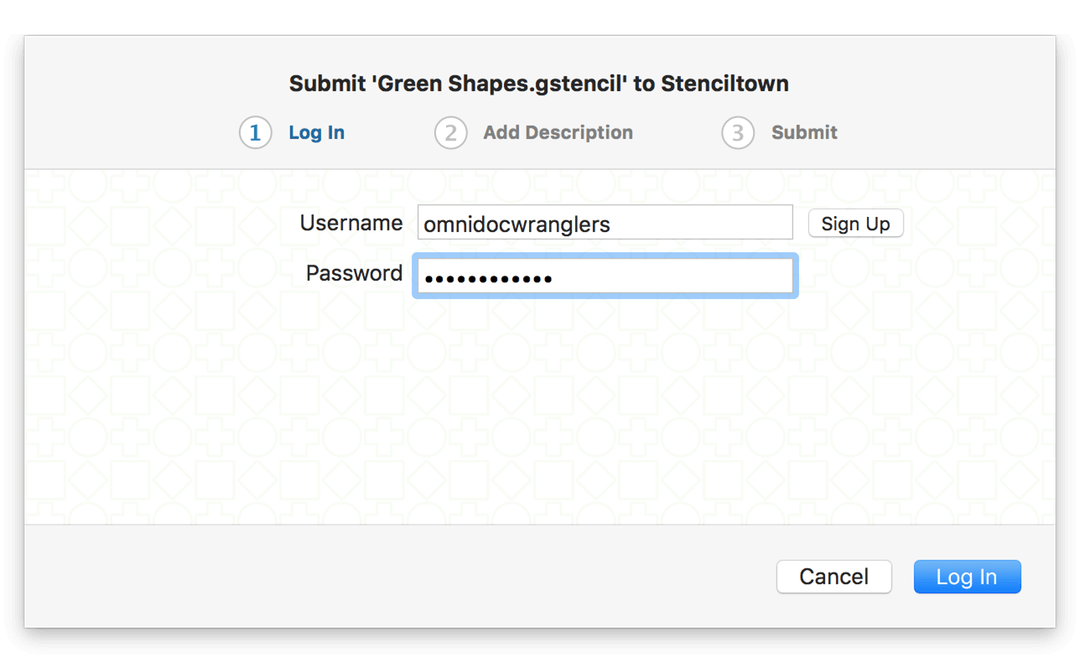
-
Enter a Name and Description for the stencil (OmniGraffle automatically uses the first canvas in the file for the preview image).
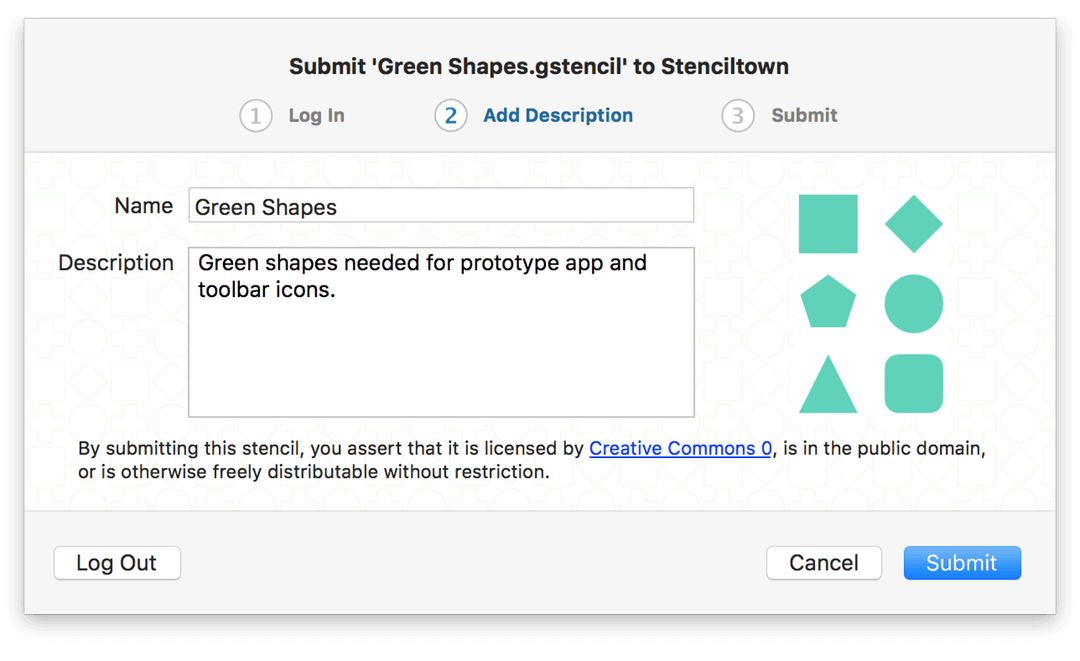
-
Click Submit.
After you click Submit, OmniGraffle submits the stencil to Stenciltown and links it to your account.
If you want to make changes to the stencil name or description, or to remove the stencil from Stenciltown:
- Log in on the Stenciltown website.
- Click the icon next to your Omni ID in the upper-right.
- Click Stencils to see the stencils you have submitted to Stenciltown, and then choose the stencil you would like to update or delete.
For more information about Stenciltown, or to create your account, see the Stenciltown FAQ.
